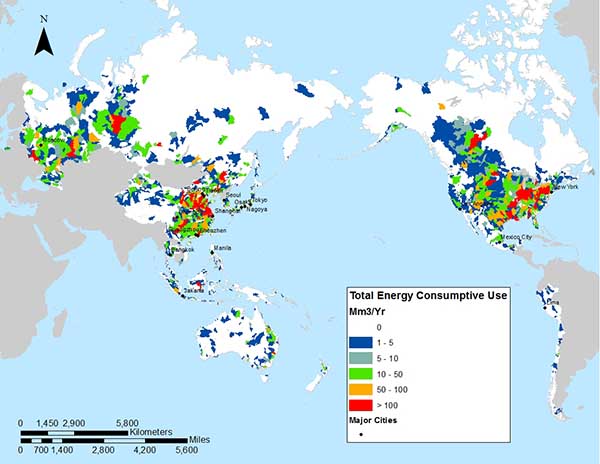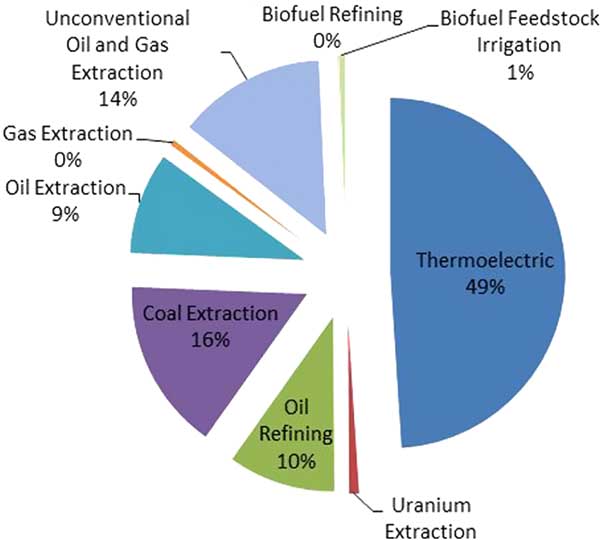Study maps water-energy dependence in Pacific Rim

A new report from Sandia maps fresh water for energy consumption in context with economies facing extreme water risk. Click on image for a larger map.
A wide-ranging analysis of water vulnerability across the Pacific — including the US, China, Russia, and Japan — has identified hundreds of locations where energy production depends upon scarce water supplies.
The Sandia study, “Mapping Water Consumption for Energy Production Around the Pacific Rim,” was published in Environmental Research Letters.
Prepared for the Asia-Pacific Economic Cooperation (APEC), a regional economic forum, the first-of-its-kind report maps out every power plant, refinery, and mine in 21 Asia-Pacific economies that rely on fresh water for energy. Simultaneously, it shows the data in context to regions at high to extreme risk of drought and dwindling natural water supplies.
“This is the first time we have worked on a project of this scale to illustrate how much fresh water is used for energy development,” says Sandia hydrologist Vince Tidwell, who co-authored the report with technologist Barbie Moreland. “The purpose was to lay out a foundation to raise awareness in these economies about energy-water issues and vulnerabilities they are facing.”
The report compares demand in 10 energy sectors where fresh water is consumed to produce energy — including thermoelectric and hydroelectric power production; coal, uranium, natural gas, and oil extraction; refining of biofuels, oil, and natural gas; and production of biofuel feedstocks.
Energy facilities in locations facing water risk
Among the 21 APEC economies are some of the world’s biggest energy users, where economics, population growth, and other factors contribute to mounting water demands. The US alone has more than 1,200 thermoelectric power plants, more than 500 refineries, and 800-plus mines.
Vince says he was surprised by the number of energy facilities across Asia-Pacific economies in locations facing water risk. The study identified 32 percent of the 2,511 watersheds consuming fresh water for energy are also characterized as being at high to extreme risk of running out of fresh water. For six of the economies, watersheds at risk represented half or more of all basins consuming water for energy.

Percent water consumption by energy sector in the Asia-Pacific Economic Cooperation (APEC) region. In total, 38.9 billion cubic meters per year of water was consumed by the energy sector across the APEC economies (excluding hydropower). As the chart above shows, thermoelectric power generation was by far the largest consumer of water at 19.0 Bm3 yr−1 or 49 percent of consumption. In thermoelectric power generation fresh water is consumed in the process of cooling steam back to liquid water. (Image credit: Sandia National Laboratories)
“Where we have energy growth and demand in regions with high or extreme water risk, we start to worry. Our hope is the hard data in this publication will get people to pay attention,” Vince says.
APEC’s Energy Working Group recently established an Energy Resilience Task Force co-chaired by DOE for the US and the Philippines. One major work stream under this new task force is to address energy-water nexus challenges. This Sandia report helps develop a baseline understanding of challenges across the APEC region so additional activities may be developed.
The study also supports DOE’s Water-Energy Nexus program, generated from the 2014 report, The Water-Energy Nexus: Challenges and Opportunities, outlining the interdependence between energy and water. It was funded for APEC by DOE’s Office of International Affairs.
Sandia based the Asia-Pacific study on its decades of experience analyzing water data and developing water models, along with expert research in water technology and development. Sandia’s core mission to solve complex national security problems includes safeguarding resilient and sustainable energy-water systems.